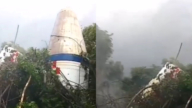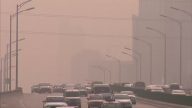【新唐人2013年10月15日訊】英國知名雜誌《經濟學人》,擁有全球廣大的讀者群,其中包括具有巨大影響力的各國決策者和企業家。最新一期的《經濟學人》刊登文章表示,中國北方缺水,補救計劃飲鴆止渴。文章大大的批評了中共當局所開展的南水北調工程,以及三峽水壩和河川污染問題。接下來請看報導。
最新一期的《經濟學人》報導,中國有霧霾、生態環境破壞等問題,但只要詢問任何一個環境問題專家,他們都會回答說,中國面臨的最嚴重問題是「水」。
英國廣播公司《BBC》13號引述《經濟學人》的文章說,中國的水資源五分之四分佈在南方,但全中國有一半的人口和三分之二的耕地卻集中在北方。中國每年用水6000億立方米,人均用水量每年400立方米。但北京的缺水堪比沙特阿拉伯,人均每年只有100立方米。自1970年代以來,北京的地下水位已經下降了300米。
大陸民間水利專家張峻峰:「按照人口比例來說,人均用水量嚴重缺乏,拿北京做例子,北京人均用水量大約在110立方米每人每年,相當於世界用水量的十分之一。」
據中共喉舌媒體《中新社》報導,中共科學院院士劉昌明,9月參加一個論壇會議時表示,河北省近年來地下水下降速度驚人,上世紀50-60年代,地下水在2-3米左右,現在下降到20-30米。
《經濟學人》說,由於過份用水,中國的很多河流乾涸消失。更為雪上加霜的是,中國還在繼續污染所剩不多的水資源。2007年,黃河水利委員會沿著13000公里的黃河調研,結果發現黃河沿岸建了4000個石化工廠,三分之一的黃河水甚至都不適用於灌溉。
而中共環保部8月20號公布的《2013年上半年全國環境品質狀況》中也披露﹕今年上半年在全中國的地標水控斷面中,出現了22次的重金屬超標現象,嚴重的汞污染超標九倍、砷次之﹔地區中天津海河流域最為嚴重。
張峻峰:「工業的污染還是侷限於具體的河流,生活污染和工業污染幾乎都是屬於線狀的,農藥的污染屬於面狀這樣一個狀況。」
2010年,由中國地質調查局進行的一項研究表明,中國華北平原75%以上的地下水,未經適當淨化,無法直接飲用。
今年,中國地質調查局發佈了另一份關於中國地面污染的報告,最新的數字顯示,中國90%的地下水受到污染,其中很大一部分受到了嚴重污染。
《經濟學人》的文章還指出,中共領導人應對水資源問題的辦法,就是興建水利項目。但文章警告,三峽水庫以及更大規模的南水北調工程,對環境的破壞將是巨大的。
時事評論員 林子旭:「中國目前的環境危機完完全全就是中共一手造成的,中共奪權初期,他們抱著改天換地的可笑思想胡作非為,到了今天中共的官員為了政績、為了個人利益更加變本加厲的破壞著中國的環境。」
中共的三峽工程、南水北調工程投資幾千億,卻備受爭議。大量資金投入是否能解決水災及北方乾旱的問題﹖是否會給地質帶來意想不到的破壞﹖尤其2008年發生汶川大地震後,更引發了大陸內、外水利專家要求拆除三峽大壩的浪潮。
而2010年中國西南大旱、2011年長江中下游乾旱,這些都引發大眾對南水北調工程的質疑。南方是否有足夠的水資源可以調配給北方﹖當面臨氣候變化時,南水北調工程是否對長江流域的生態環境產生深遠的影響﹖都令百姓擔憂。
英國雜誌最後結論說,水危機讓中共當局「病急亂投醫」,但卻根本於事無補。
採訪編輯/田淨 後製/鍾元
The Economist: Questions Over Northern China Water Shortage Project
Prominent UK publication The Economist
has a large global audience, including
influential policy-makers and entrepreneurs.
The latest issue published an article criticizing
water shortage remediation plans in northern China.
It criticized the Chinese authorities carrying out
the south-to-north water transfer project, as well
as the Three Gorges dam and river pollution.
Let’s look at the report.
The latest issue of The Economist reported on China’s
dense pollution haze and environmental destruction.
It also indicated environmental experts consensus that
the most serious problem facing China is it’s water .
On October 13, the BBC quoted The Economist article.
It said that four-fifths of water sources
are distributed in the South of China.
However, half of the population, and two thirds of
the arable land are concentrated in North of China.
China has 600 billion cubic meters of water usage per year,
and 400 cubic meters water consumption per capita per year.
Beijing’s water shortage is now comparable
to Saudi Arabia’s, with 100 cubic meters
of water consumption per person per year.
Since the 1970s, Beijing’s water
table has dropped 300 meters.
Zhang Junfeng, China water expert: “China is suffering
from severe shortages of water available for consumption
per capita, according to the proportion of the population.
For example, Beijing has 110 cubic meters
of water per capita per year for consumption.
This is equivalent to one-tenth of the world standard."
State-controlled Chinese media reported that Liu Changming,
who is an academic from the Chinese Academy of Sciences
attended a forum meeting in September.
He said that Hebei groundwater has declined
at an incredible speed during recent years.
The groundwater was 2-3 meters deep in the
50’s and 60’s, and is now 20 to 30 meters deep.
The Economist reported that due to excessive
water use, many rivers have disappeared.
It is even worse that China continues
to pollute it’s few remaining water sources.
In 2007, the Yellow River water resources committee did
research along the 13,000 kilometers of Yellow River.
It found that around 4,000 petrochemical
factories were built along the river system.
Almost a third of the Yellow River water
was now not useable for irrigation.
On August 20, the Chinese Communist Party (CCP)
Environment Ministry announced it’s “national
environment quality report for the first half of 2013″.
It indicates that safety levels have
been exceeded with 22 heavy metals.
Severe mercury pollution has exceeded safe levels
by nine times, and is closely followed by arsenic.
Tianjin’s Haihe River Basin is most
severely impacted by pollution.
Zhang Junfeng: “Industrial pollution
is still limited to specific river pollution.
Domestic pollution and industrial pollution are linear
trends, while pesticide contamination is planar."
In 2010, China Geological Survey conducted a study.
It showed that more than 75% of groundwater under the
North China Plain cannot be used because of impurity.
This year, the China Geological Survey issued
another report on ground contamination levels.
Latest figures show 90% of China’s groundwater is
contaminated, with a large proportion severely polluted.
The article went on to say that the CCP leaders have
reacted to water problems by building engineering projects.
The Three Gorges dam and South-North Water Diversion
Project could cause enormous damage to the environment.
Lin Zixu, current affairs commentator: “The current
environmental problems are entirely caused by the CCP.
A fundamental CCP ideology is to
control and change heaven and earth.
Nowadays, CCP officials want to show off their
achievements, and to obtain personal interests.
Therefore, it intensifies the destruction of the environment."
The CCP has invested several hundred billion dollars in the
Three Gorges Dam and South-North Water Diversion Project.
This has aroused many controversies.
Can investment of a great amount of money solve
the problems of flooding and drought in the North?
Or could it bring some unexpected geological damage?
After the Wenchuan earthquake took place in 2008,
water experts both inside and outside China raised
demands for removing the Three Gorges Dam.
In 2010, Southwest China was hit by severe drought.
In 2011, midstream and downstream
of the Yangze River were in drought.
This provoked the public to question
the South-North Water Diversion Project.
Is there sufficient water resources in
the South to be diverted to the North?
When the climate changes, will the South-North
Water Diversion Project impact the Yangtze River’s
ecological environment? People are very worried.
The Economist concludes that this water crisis is driving
China to desperate, but ultimately unhelpful measures.




























